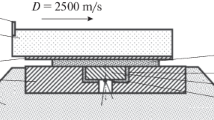Abstract
This paper describes the calculation of the relationship of the critical ambient temperature at which lead α-azide is ignited and the relationship of the critical temperature of self-heating with the thickness of plane crystals with the use of the Semenov criteria and numerical solution of the differential equation of heat balance. The stability of the heat balance equation is analyzed. Analytical expressions for the determination of critical ambient temperatures and self-heating temperatures. The calculations are carried out with the parameters of the heterogeneous reaction of thermal decomposition of lead azide in the mode of decreasing volume. The calculations results are in good agreement with the known experimental data. It is shown that the larger the activation energy of the exothermic reaction, the stronger the relationship of the critical temperature of ignition of lead α-azide with the thickness of plane crystals.
Similar content being viewed by others
References
P. G. Fox and R. W. Hutchinson, “Slow Thermal Decomposition,” in Energetical Materials, Ed. by H. D. Fair and R. F. Walker, Vol. 1 (Plenum Press, New York, 1976).
F. P Bowden and A. D. Yoffe, Fast Reactions in Solids (Academic Press, 1958).
J. Jach, “Thermal Decomposition of Irradiated a-Lead Azide,” Trans. Faraday Soc. 59 (484), 947–358 (1963).
P. G. Fox, “The Explosive Sensitivity of the Metal Azides to Impact,” J. Solid State Chem. 2 (4), 491–502 (1970).
R. W. Hutchinson, S. Kleinberg, and F. P. Stein, “Effect of Particle-Size Distribution on the Thermal Decomposition of a-Lead Azide,” J. Phys. Chem. 77 (7), 870–875 (1973).
M. E. Brow, D. Dollimore, and A. K. Galwey, “Reactions in the Solid State,” in Comprehensive Chemical Kinetics Ed. by C. F. H. Tipper and C. H. Bamford (Elsevier, Amsterdam, 1980).
J D. Danforth, S. R. Porter, and D. Stricler, “The Acceleratory Degradation of Solids According to Non-Steady- State Kinetics,” J. Solid State Chem. 54, 34–48 (1984).
M. M. Chaudhri and J. E. Field, “The Effect of Crystal Size on the Thermal Explosion of a-Lead Azide,” J. Solid State Chem. 12, 72–79 (1975).
T. B. Tang and M. M. Chaudhri, “The Thermal Decomposition of Silver Azide,” Proc. Roy. Soc. London A369, 83–104 (1979).
A. V. Khaneft, “Topochemical Model of Autocatalytic Decomposition of Lead Azide,” Zh. Fiz. Khim. 66 (7), 1772–1778 (1992).
A. V. Khaneft, “The Heterogeneous Mechanism of Lead Azide Thermal Decomposition,” in Energetic Materials: Characterisation, Modeling and Validation: 40th Int. Annu. Conf. of ICT, Karlsruhe, Germany, June 23–26, 2009.
G. B. Manelis, “Some Features of the Mechanism of Reactions in the Solid Phase,” in Problems of Kinetics of Elementary Chemical Reactions (Nauka, Moscow, 1973) [in Russian].
A. V. Khaneft, “Heterogeneous Mechanism of Thermal Decomposition of Lead Azide,” Materialovedenie, No. 8, 7–14 (2005).
A. V. Khaneft, “The Mechanism of Formation of Molecular Nitrogen by the Decomposition of Lead Azide,” Zh. Fiz. Khim. 70 (4), 639–642 (1996).
A. V. Khaneft, “Estimation of the Normal Component of the Growth Rate of Lead Cores in Thermal Decomposition of Lead Azide,” Zh. Fiz. Khim. 75 (1), 19–23 (2001).
A. V. Khaneft, “Autocatalysis of Thermal Decomposition of Lead Azide by the Schottky Defects with Low Degrees of Decomposition,” Izv. Vyssh. Uchebn. Zaved., Fiz. 54 (1/3), 303–307 (2011).
A. Ya. Appin, “Thermal Decomposition and Explosion of Lead Azide,” in Collection of Articles on the Theory of Explosives, Ed. by K. K. Andreev and Yu. B. Khariton (Gos. Izd. Oboron. Prom., Moscow, 1940) [in Russian].
D. A. Frank-Kamenetskii, Diffusion and Heat Transfer in Chemical Kinetics (Nauka, Moscow, 1967; Plenum, New York, 1969).
A. Aoufi, “Numerical Comparison of Two Models for Lead Azide Initiation,” Izv. Vyssh. Uchebn. Zaved., Fiz. 57 (12/3), 12–15 (2014).
J. T. Hagan and M. M. Chaudri, “Low Energy Laser Initiation of Single Crystals of ß-Lead Azide,” J. Mater. Sci. 16, 2457–2466 (1981).
N. N. Semenov, Chain Reactions (Nauka, Moscow, 1986) [in Russian].
V. V. Danilenko, Explosion: Physics, Engineering, Technology (Energoatomisdat, Moscow, 2010) [in Russian].
Author information
Authors and Affiliations
Corresponding author
Additional information
Original Russian Text © A.V. Khaneft.
Rights and permissions
About this article
Cite this article
Khaneft, A.V. Relationship between the Critical Temperature of Thermal Explosion and the Thickness of a Lead Azide Plane Crystal. Combust Explos Shock Waves 54, 82–88 (2018). https://doi.org/10.1134/S0010508218010124
Received:
Revised:
Published:
Issue Date:
DOI: https://doi.org/10.1134/S0010508218010124



